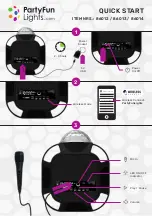
13
Northern Industrial Welder
Operating Instructions and Parts Manual
MIG 130
the faster the travel speed, the lower
the penetration and the lower and
narrower the finished weld bead.
Likewise, the slower the travel speed,
the deeper the penetration and the
higher and wider the finished weld
bead.
6.2 Types of welding bead
As you become more familiar with
your new welder and better at laying
some simple weld beads, you can
begin to try some different weld bead
types.
The STRINGER BEAD is formed by
traveling with the torch in a straight
line while keeping the wire and nozzle
centered over the weld joint. See
following figure.
The WEAVE BEAD Used when you
want to deposit metal over a wider
space than would be possible with a
stringer bead. It is made by weaving
from side to side while moving with
the torch. It is best to hesitate
momentarily at each side before
weaving back the other way.
6.3 Welding position
FLAT POSITION
is easiest of the
welding positions and is most
commonly used. It is best if you can
weld in the flat position if at all
possible as good results are easier to
achieve.
HORIZONTAL POSITION It is
performed very much the same as
the flat weld except that angle B (see
HOLDING THE TORCH) is such that
the wire, Directed more toward the
metal above the weld joint is to help
prevent the weld puddle from running
downward while still allowing slow
enough travel speed .A good starting
point for angle B is about 30 degrees
DOWN from being perpendicular to
the work piece
.
VERTICAL POSITION It is easier for
many people to Pull the torch from
top to bottom. It can be difficult to
prevent the puddle from running
downward. Pushing the torch from
bottom to top may provide better
puddle control and allow slower rates
of travel speed to achieve deeper
penetration. When vertical welding,
angle B (see HOLDING THE TORCH)
is usually always kept at zero, but
angle A will generally range from 45
to 60 degrees to provide better
puddle control.
OVERHEAD POSITION It is the most
difficult welding position. Angle A (see
HOLDING THE TORCH) should be
maintained at 60 degrees.
Maintaining this angle will reduce the
chances of molten metal falling into
the nozzle. Angle B should be held at
zero degrees so that the wire is










































